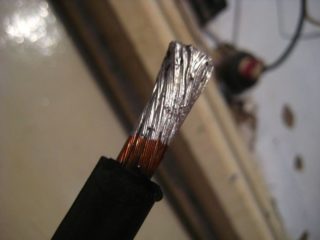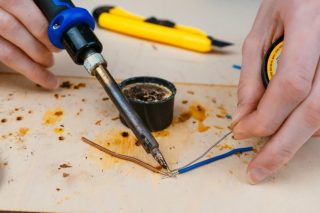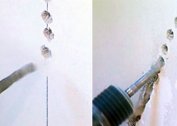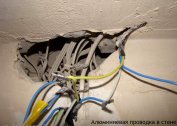During repair, modernization or when installing electrical wiring, special attention is paid to the quality of the connection of conductive wires. Reliable soldered joints are the key to the safe operation of electric lines and household appliances. To fix the solder well, it is required to first irradiate the wires, the essence of the procedure is to cover the surface with tin.
Why tinning wires is so important
Before tinning the wire, you need to find out why this procedure is so necessary. When interacting with oxygen, copper and aluminum oxidize, forming an oxide film on its surface, which impairs conductivity and increases resistance. Tinning of wires avoids this. The wires are tin-plated with lead-tin solders, their advantage is a long service life, safety and reliability.
Also, tinning is used during soldering, for example, when connecting LED strips to the power supply. If the wires of the lighting device are not previously irradiated, over time all the wires will fall off.
Service wire using a soldering iron
For high-quality performance of work, it is important to confidently own a soldering iron. If there are no fixed skills, you will not be able to tin and solder the wire.
There are different models of soldering irons, each with its own technical characteristics - power, dimensions, etc. It is recommended for a novice master to give preference to soldering stations, where it is possible to adjust the heating temperature independently.
It is advisable to purchase an expensive device, since the process will take less time, and the work will be performed in joy.
Necessary tools
Installation, modernization, repair and maintenance of wires is troublesome, but not complicated. To reduce the time spent, pre-prepare all the necessary tools and supplies for the job. The list is as follows:
- consumables include solder and flux;
- sharp knife;
- soldering station or soldering iron;
- technical or medical tweezers;
- ordinary pliers.
You can use not a well-sharpened knife, but special pliers that allow you to remove the entire insulation layer in a few movements. But their cost is quite high, so many use a knife or a scalpel.
In each case, a certain solder and flux composition for cables are required, this must be taken into account.
Procedure
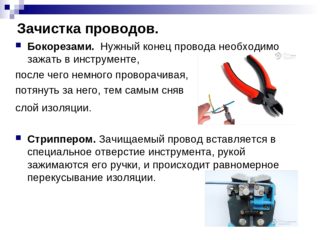 To irradiate a wire, you need to follow the following algorithm:
To irradiate a wire, you need to follow the following algorithm:
- Using a special tool, knife or scalpel, remove the insulating layer from the wires that need to be connected.
- After removal of the insulating material, conductive conductors must be stripped to a characteristic shine. To do this, you can use a knife or sandpaper. If the work is not a cast wire, but a stranded wire, each posting is fluffed and stripped separately.
- A soldering iron is plugged into the outlet and cleaned of all the contaminants that he likes to collect, especially old solder and dust. When cleaning the soldering iron core, it is recommended to use a small emery paper.
- It is necessary to warm up the tip of the wire. This can be done using a soldering iron, gas burner or a conventional lighter.
- When the soldering iron has warmed up to working temperature, its residential touch the solder and rosin. The working surface should be abundantly covered with melted tin.
- The next step is to touch the copper conductor with a hot soldering iron. Solder should be evenly distributed throughout the vein. To apply solder, pliers and tweezers are used.
- At the end of work, a cable or wire is carefully inspected. The working surface must be completely and evenly coated with solder. Empty cavities or accumulations of matter should be absent. If defects in the work are found, the procedure is repeated.
If you have to work with very thin wires, it is better not to use rosin, since it is very difficult to calculate the exact amount of substance. Soldering acid is suitable as an analog. The tip of the conductor can be treated with an ordinary brush. After this, you can begin to apply solder. This method cannot be called more reliable, but with such types of wiring it is impossible otherwise.
Wire Processing Methods
There are several ways to tin. Some masters prefer the method, the essence of which is to press the wires with a soldering iron to a wooden flat surface.
When heated, gases are released from the tree, which play the role of a flux, contributing to the removal of oxides on the metal.
It is possible to remove oxide film on the surface of conductive wires with higher quality using aspirin. During operation, the tablet is placed under the wires. When heated, gases are released from acetylsalicylic acid, enveloping the junction, displacing impurities from them, adversely affecting the quality of the compound. This simple and budget-friendly method provides high-quality tinning.
There is another way to prepare stranded cables and wires in which the copper base is coated with enamel. As a substrate, it is preferable to use a small piece of PVC material. During thermal exposure, polyvinyl chloride begins to actively release hydrogen chloride, which effectively destroys the oxide layer.
Tinning by dipping
 If you have to work with wires and cables of large diameter, then the preparation should be carried out differently. Complete and uniform distribution of solder in this case is not easy to achieve.
If you have to work with wires and cables of large diameter, then the preparation should be carried out differently. Complete and uniform distribution of solder in this case is not easy to achieve.
There is a special device - a crucible, in which small pieces of tin are placed. There they are heated, as a result, a molten metal. The end of the wire is pre-immersed in rosin or other grades of flux, and then in the capacity of the crucible. This approach provides a complete and uniform distribution of substances at the cut site.
Use this method only with fully tinned wires. Diving is already on a completely different scale, and is carried out in an industrial environment. The process is implemented using a special coil with a wound wire. First, the entire copper surface is manually treated with stiff brushes, previously their bristles are treated with zinc chloride in liquid form. Dissolved flux is obtained from a mixture of industrial hydrochloric acid and zinc.
Next, the wire from the coil begin to slowly unwind and dip into a container filled with dissolved tin. The uniformity of the coating is ensured by the secondary processing of the cable or wire of large diameter with rubber brushes. Finally, the cable is immersed in a container of cold water and again treated with brushes. After that, the wires and cables are wound and packaged for further sale in construction stores.
